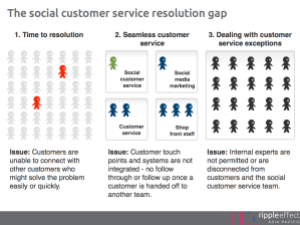for W3c validation
While we remain a little dubious about the long term impact of group protests on social media (so called, ‘slacktivists’), there is no doubt that social media has become a popular channel for individuals to seek help, ask questions or provide feedback about products and services. Of course while some customers might hope that a tweeted complaint or post on a brand’s Facebook page will give them extra leverage, most people are just looking for a convenient way to get the help or support they want.
But often that social customer service process fails to live up to expectations. Do any of the following scenarios sound familiar?
- You make a complaint but just get platitudes, not actual help.
- You ask a simple question but are redirected to a traditional customer service channel.
- Your enquiry is treated as a low priority, simply because you didn’t pick up the phone or walk in the store.
With Australia and Asia home to a large number of active social network users, why are companies and other organisations, including government agencies, delivering a poor customer service experience online?
Some are simply not prepared (yet) to engage online with customers other than for marketing and promotional purposes. Some will argue that customer privacy stops them, although this can be dealt with using the right tools and processes.
But once a company decides to start interacting more purposefully with customers through social media, part of the challenge of social customer service becomes one of co-ordinating how to respond efficiently and in a way that is scalable and cost effective. When this fails, it is because of a social customer service fulfilment gap that manifests itself in the following ways:
- Time to resolution – Customers are unable to connect with other customers who might solve the problem easily or quickly.
- Seamless customer service – Customer touch points and systems are not integrated – no follow through or follow up once a customer is handed off to another team.
- Dealing with customer service exceptions – Internal experts are not permitted or are disconnected from customers and the social customer service team.
These are systemic issues in an organisation and improving the effectiveness of social customer service is a fundamental indicator of social business maturity. The actual cause could be missing policies and procedures, the wrong technology, an inability for different departments to work together or a combination of issues – but from the customer perspective the process fails because they are left with an unresolved problem.
For example, many organisations risk treating crowdsourcing as simply an option to reduce support costs, rather than embracing it as an approach that is cost effective to scale but also adds value to the customer at the same time (for example, fast problem resolution).
Crowdsourcing customer service only works in situations where the product or service is something that is under the customer’s control and typical solutions to many problems are achievable with a reasonable level of skill. In other words, it actually needs to be possible for customers to solve their own problems themselves. A pathway for escalating hard to solve problems and aggregating feedback so that emerging issues can be addressed proactively also needs to exist. Without this safety net, crowdsourcing simply becomes ‘hands off’ customer service. The benefits of scale that social media can provide will also be missed.
How are you dealing with social customer service? Are any of your customers falling through the gaps?






for W3c validation
[…] Are your customers falling through a social customer service gap? « Ripple Effect Group […]